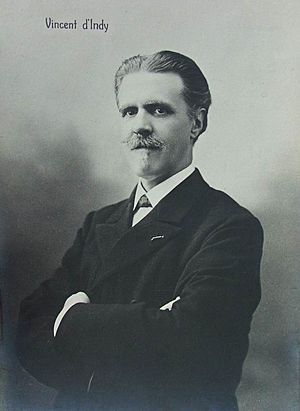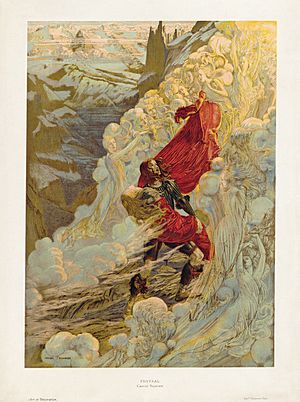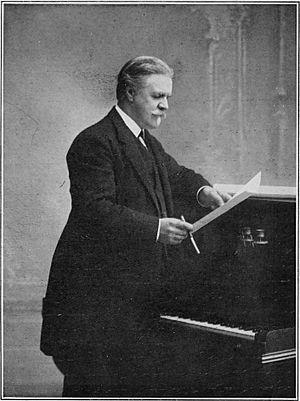Vincent d'Indy facts for kids
Paul Marie Théodore Vincent d'Indy (born March 27, 1851 – died December 2, 1931) was a French composer and teacher. He was very important as a teacher, helping many students learn music. He helped start the Schola Cantorum de Paris, a famous music school. He also taught at the Paris Conservatoire. Some of his well-known students included Albéric Magnard, Albert Roussel, Arthur Honegger, Darius Milhaud, and even Cole Porter.
D'Indy learned from the composer César Franck. Franck really liked German music, and this influenced d'Indy a lot. At that time, countries had strong national feelings, especially around the Franco-Prussian War of 1871. This caused some arguments because other French musicians wanted French music to be separate from German influences.
Contents
Life Story of Vincent d'Indy
Vincent d'Indy was born in Paris into a wealthy family that supported the king and the Catholic Church. He started piano lessons very young with his grandmother. She then sent him to learn from famous piano teachers like Antoine François Marmontel and Louis Diémer.
Early Studies and Inspiration
When he was 14, d'Indy began studying harmony with Albert Lavignac. At 16, his uncle showed him a book by Hector Berlioz about how to arrange music for an orchestra. This book made him want to become a composer. He wrote a piano piece and sent it to César Franck, who was a teacher of one of his friends. Franck saw that d'Indy had a lot of talent and told him to become a composer.
Joining the Military and Returning to Music
At 19, during the Franco-Prussian War, d'Indy joined the National Guard. But as soon as the fighting ended, he went back to music. In 1871, he joined Franck's organ class at the Conservatoire de Paris. He stayed there until 1875. To get more experience, he then joined the percussion section of the orchestra at the Châtelet Theatre. He also led the chorus for the Concerts Colonne.

His first piece to be played by an orchestra was a Symphonie italienne. Famous composers like Georges Bizet and Jules Massenet liked it.
Travels and Influences
In the summer of 1873, he visited Germany. There, he met other great composers like Franz Liszt and Johannes Brahms. In 1874, his overture Les Piccolomini was performed. Around this time, he married Isabelle de Pampelonne, who was his cousin. In 1875, his symphony for John Hunyadi was played. That same year, he had a small role as a prompter in the first show of Bizet's opera Carmen. In 1876, he saw Richard Wagner's Ring cycle at Bayreuth. This experience deeply impressed him, and he became a big fan of Wagner's music.
Composing and Teaching
In 1878, d'Indy's orchestral piece La Forêt enchantée was performed. He continued to compose many works, including his music drama Fervaal, which he worked on from 1889 to 1895.
D'Indy was inspired by his teacher Franck, but he wasn't happy with how music was taught at the Conservatoire. So, in 1894, he teamed up with Charles Bordes and Alexandre Guilmant to start a new school called the Schola Cantorum de Paris. D'Indy taught there until he passed away, becoming the principal in 1904. The school focused on teaching strong musical skills. D'Indy also taught at the Conservatoire later on.
Many important musicians studied with d'Indy, including Albéric Magnard, Albert Roussel, Joseph Canteloube, Arthur Honegger, and Darius Milhaud. Even Cole Porter and Erik Satie studied there for a while. Even though some students found his teaching strict, his influence as a teacher was huge and helped French music a lot.
Leadership in Music Societies
D'Indy also played a big role in the Société nationale de musique, a group for French composers. His teacher, Franck, had helped start it. D'Indy admired German music, just like Franck. He didn't like that the society only allowed French music. In 1885, he became a secretary and helped change the rule so non-French music could be included. This made some of the founders, like Camille Saint-Saëns, resign. When Franck died in 1890, d'Indy became the president. However, his leadership style led a younger group of composers, including Maurice Ravel, to start their own group, the Société musicale indépendante, in 1910.
Later Life and Legacy
After his first wife passed away in 1905, d'Indy's views became more traditional and strong. He joined a group called the Ligue de la patrie française.

During the First World War, d'Indy traveled to other countries to share French culture. He also finished his third music drama, La Légende de Saint-Christophe. After the war, he conducted more concerts across Europe and the US. In 1920, he married Caroline Janson. This marriage brought him new energy, and he wrote many calm, Mediterranean-inspired pieces in his last years.
Vincent d'Indy passed away in Paris on December 2, 1931, at the age of 80. He is buried in the Montparnasse Cemetery.
Vincent d'Indy's Musical Works
Today, not many of d'Indy's works are played often in concerts. However, his love for composers like Beethoven and Franck sometimes makes people overlook how unique his own music was, especially his beautiful orchestral pieces about southern France.
Famous Compositions
Among his most famous pieces are the Symphony on a French Mountain Air for piano and orchestra (1886). Another well-known work is Istar (1896), which is a symphonic poem. A symphonic poem is a piece of music that tells a story or describes something. Istar is special because it's a set of variations where the main tune (theme) only appears at the very end.
D'Indy wrote other orchestral pieces, including a Symphony in B♭. He also composed a large symphonic poem called Jour d'été à la montagne (Summer Day in the Mountains) and another called Souvenirs, which he wrote after his first wife died. Music experts say that you can hear the influence of Berlioz, Franck, and Wagner in almost all his music.
Other Works and Contributions
His chamber music, which is for small groups of instruments (like his three string quartets), is generally less famous than his orchestral works. He also wrote piano music, songs, and several operas, including Fervaal (1897) and L'Étranger (1902). His music drama Le Légende de Saint Christophe, which used old church music (Gregorian chant), was first performed at the Paris Opéra in 1920.
D'Indy helped bring back many old Baroque musical works that people had forgotten. For example, he made his own version of Monteverdi's opera L'incoronazione di Poppea. He also helped revive the works of Antonio Vivaldi, editing some of Vivaldi's cello sonatas to be played as cello concertos.
He also wrote books about music, including a three-volume guide to composing music called Cours de composition musicale. He also wrote studies about Franck and Beethoven. His book about Franck is considered a very lively and unique French biography.
Honoring Vincent d'Indy
A private music school in Montreal, Canada, called the École de musique Vincent-d'Indy, is named after him. Also, an asteroid discovered in 1992 is named 11530 d'Indy in his honor.
See also
 In Spanish: Vincent d'Indy para niños
In Spanish: Vincent d'Indy para niños




